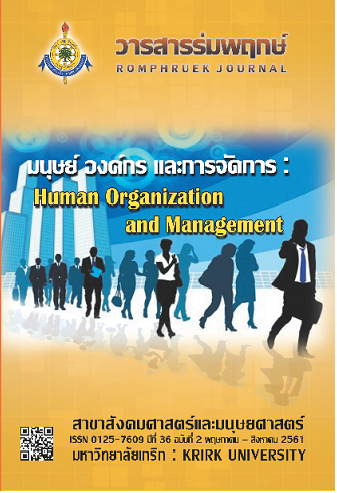The Causal Model of Organizational Commitment of Officers in the Department of Skill Development
Main Article Content
Abstract
The objectives of this research were to 1) examine the levels of organizational commitment (OC) and 2) examine the causal model of OC of officers in the Department of Skill Development (DSD). The questionnaires were sent and the data were collected from 160 respondents. Data analysis was conducted using both descriptive statistics comprising of frequency, percentage, mean and standard deviation including inferential statistics comprising of Pearson’s Product Moment Correlation Coefficient and Multiple Regression Analysis (MRA). The model was examined by the path analysis technique using empirical data.
The study revealed that:
1) The overall OC level of DSD officers was high (=4.03). When each aspect was considered separately, it was found that the OC level of every aspect was high as well. Considering at each aspect, ranging from the highest mean score to the lowest was as follows: dedication to the job, acceptance of the organization’s goal and willing to maintain being organizational membership (=4.35, 4.04 and 3.71, respectively).
2) The causal model of OC of DSD officers revealed that the satisfaction on job performance had direct influence on organizational commitment whereas the value on job performance had an indirect influence through both promotion and satisfaction on job performance or through internal relationship, promotion and satisfaction on job performance. The promotion also had an indirect influence through satisfaction whereas internal relationship had an indirect influence through promotion and satisfaction on job performance
Article Details
Every article published in the Romphruek Journal of the Humanities and Social Sciences is the opinion and point of view of the authors. Thery're not the viewpoint of Krirk University or the editored department. Any part or all of the articles for pablication must be clearly cited.
References
กรมพัฒนาฝีมือแรงงาน. (2557ก). รายงานประจำปี 2556. กรุงเทพฯ : กองแผนงานและสารสนเทศ กรมพัฒนาฝีมือแรงงาน.
กรมพัฒนาฝีมือแรงงาน. (2557ข). ข้อมูลบุคลากรของกรมพัฒนาฝีมือแรงงาน. กรุงเทพฯ : กองการเจ้าหน้าที่ กรมพัฒนาฝีมือแรงงาน.
ทิพย์ทินนา สมุทรานนท์ ศิรินภา จามรมาน พิชญา ทองคำพงษ์ สาริณี โตอรุณ และสไบทอง ชัยประภา. 2547. ค่านิยมในการทำงาน ความผูกพันต่อองค์การ ความพึงพอใจในการทำงาน แรงจูงใจใฝ่สัมฤทธิ์ และพฤติกรรมการทำงานของหัวหน้างานธุรกิจอุตสาหกรรมสิ่งทอ โครงการพัฒนาผู้ประกอบการธุรกิจอุตสาหกรรม. วารสารสังคมศาสตร์และมนุษยศาสตร์. 30 (1), 46 – 62.
ธณัฐชา รัตนพันธ์. (2550). การพัฒนาโมเดลเชิงสาเหตุของความผูกพันต่อองค์กรของพนักงานมหาวิทยาลัยสายสนับสนุนวิชาการในเขตกรุงเทพมหานครและปริมณฑล. วิทยานิพนธ์ปริญญาครุศาสตรมหาบัณฑิต สาขาวิจัยการศึกษา คณะครุศาสตร์ จุฬาลงกรณ์มหาวิทยาลัย.
ธิติวัฒน์ แจ่มศักดิ์. (2547). ปัจจัยที่มีความสัมพันธ์กับความผูกพันต่อองค์กรของข้าราชการศูนย์การอุตสาหกรรมป้องกันประเทศและพลังงานทหาร. ปัญหาพิเศษปริญญารัฐประศาสนศาสตรมหาบัณฑิต สาขาวิชารัฐประศาสนศาสตร์ บัณฑิตวิทยาลัย มหาวิทยาลัยบูรพา.
พิชิต พิทักษ์เทพสมบัติ จินดาลักษณ์ วัฒนสินธุ์ และ ไชยนันท์ ปัญญาศิริ. (2552). ความพึงพอใจในงานและความผูกพันต่อองค์การความหมาย ทฤษฎี วิธีวิจัย การวัด และงานวิจัย. พิมพ์ครั้งที่ 2. กรุงเทพฯ : สำนักพิมพ์เสมาธรรม.
ราชบัณฑิตยสถาน. (2557) เจตคติ. สืบค้นจาก http://rirs3.royin.go.th/coinages /webcoinage.php.
สำราญ มีแจ้ง. (2544) สถิติขั้นสูงสำหรับการวิจัย. กรุงเทพฯ: นิชินแอดเวอร์ไทซิ่งกรีฟ.
สุมนา ศิริบวรเกียรติ. (2542). ศึกษาความยึดมั่นผูกพันต่อองค์กร : ศึกษาเฉพาะกรณีเจ้าหน้าที่การตลาดบริษัทเงินทุนหลักทรัพย์และบริษัทหลักทรัพย์ในเขตกรุงเทพมหานคร. วิทยานิพนธ์มหาบัณฑิต ภาควิชาสังคมวิทยา คณะสังคมวิทยาและมานุษยวิทยา มหาวิทยาลัยธรรมศาสตร์.
สุรนาท สบายรูป. (2556). แนวทางการพัฒนาความผูกพันในองค์กรของพนักงานสโมสรทหารบก (ส่วนกลาง วิภาวดี). เอกสารวิจัยส่วนบุคคล วิทยาลัยการทัพบก.
อวยพร ประพฤทธิ์ธรรม. (2537) ปัจจัยที่ส่งผลต่อความผูกพันต่อองค์กรของวิทยาจารย์ในวิทยาลัยพยาบาลภาคเหนือ. วิทยานิพนธ์ปริญญามหาบัณฑิต ภาควิชาสังคมวิทยา คณะสังคมวิทยาและมานุษยวิทยา มหาวิทยาลัยธรรมศาสตร์.
Best, J.W. (1981). Research in Education. (4th ed.). New Jersey: Pretice Hall.
Kerlinger, F.N. and Pedhazur, E.J.. (1973). Multiple Regression in Behavioral Research. New York : Holt Rinehart and Winston.
Steers, R.M. and Porter, L.W. (1983) . Motivation and Work Behavior. New York : McGraw-Hill.

